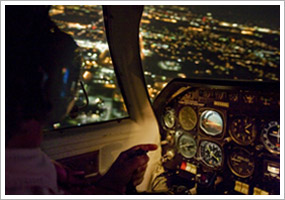| The following stories from the December 5, 2008, edition of AOPA ePilot were provided to AOPA members who expressed an interest in the particular subject areas. Any AOPA member can receive information tailored to their areas of interest by updating their preferences online. TRAINING TIPsDark night VFR
This may surprise you, but there's more than one variety of nocturnal aviation. There's night flying, and there's dark night flying—an entirely different proposition. Flying under a bright moon, perhaps above a carpet of new snow, bears no resemblance to flight on a moonless night above an unlighted landscape that may not even present a natural horizon reference outside the windscreen. Experience both with your flight instructor!
"Night flying is very different from day flying and demands more attention from the pilot. The most noticeable difference is the limited availability of outside visual references. Therefore, flight instruments should be used to a greater degree in controlling the airplane," explains Chapter 10 of the Airplane Flying Handbook . It will help for you to have already practiced some basic instrument flying before launching on dual night flights. Especially under dark night conditions, you will likely put those basic instrument skills to their first real test.
Another important adjustment to make on every night flight is proper cockpit lighting. Many pilots fly around at night with the lights up too bright, further compromising their outside vision. Use the minimum light level that still illuminates your instrument panel.
Pilotage, too, is a whole different ballgame at night. Even experienced pilots flying familiar routes have been fooled, as this Safety Spotlight from the AOPA Air Safety Foundation demonstrates. The foundation's Safety Hot Spot: Flying Night VFR includes five Safety Quizzes on night operations that will further assist you. See more night flying tips in the October 2008 AOPA Flight Training feature "Don't be afraid of the dark."
To know what kind of night conditions await, add a check of local times for the moon's rising and setting to your flight planning. (The next full moon is on Dec. 12. The full moon rises at sunset.) Then, dress warmly, put fresh batteries in your flashlights, and experience the joys and challenges of flying when the sun is no longer a factor. TRAINING PRODUCTSSporty's VFR Refresher KitDo you know a pilot who isn't flying but would like to get back into the air? Help is available from Sporty's in the form of the VFR Refresher Kit. The kit includes Flight Review, VFR Communications, Takeoffs and Landings, and Airspace and Weather Format Review DVDs; a kneeboard; flight plan forms; communications cards; a sectional plotter; a copy of the latest Federal Aviation Regulations/Aeronautical Information Manual, the Pilot's Handbook of Aeronautical Knowledge, Aviation Weather Services, and the Private Pilot Maneuvers Guide. Sold separately, the materials would run more than $240; the VFR Kit sells for $149. An IFR Refresher Kit is available for $189. Order online or call 800/SPORTYS. Note: Products listed have not been evaluated by ePilot editors unless otherwise noted. AOPA assumes no responsibility for products or services listed or for claims or actions by manufacturers or vendors. FINAL EXAMQuestion: I'm a little confused with best angle and best rate climbs. What exactly is the difference?
Answer: The best angle of climb, commonly referred to as V x, will provide the greatest gain in altitude over the shortest distance. The best rate of climb, commonly referred to as V y, will provide the greatest gain in altitude over the shortest period of time. With a V x climb, you are sacrificing forward speed in order to gain altitude in a shorter distance. More of the engine's power is directed at gaining altitude vs. moving forward. You can learn more about V x and V y climbs with the AOPA Air Safety Foundation's Essential Aerodynamics online course.
Got a question for our technical services staff? E-mail to [email protected] or call the Pilot Information Center, 800/872-2672. Don't forget the online archive of "Final Exam" questions and answers, searchable by keyword or topic. |
 Got your night flying in yet? This is the time of year to meet the night-flying requirements for your
Got your night flying in yet? This is the time of year to meet the night-flying requirements for your 